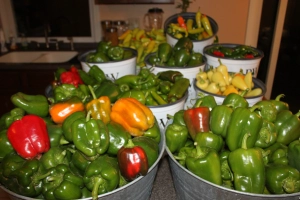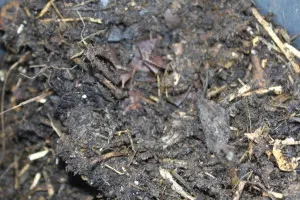Take a stroll down the produce aisle at your local grocery store and you will quickly notice that peppers have grown in popularity. No longer are we stuck settling for just the so-called “Traffic Light” varieties – those green, red and yellow bell peppers that seemed to be about the only choices we had growing up.
Peppers are now grown in hundreds of different sizes, shapes and colors – all with their own unique taste. Whether you prefer sweet peppers, savory peppers, mild peppers, ornamental peppers or our personal favorite, hot peppers – you can add beauty and taste to your garden and landscape by planting your own this year.
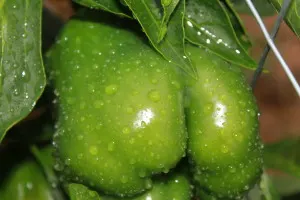
We devote a large part of our garden to growing peppers – and with good reason! We use them fresh on sandwiches, in salads, salsa and soups – or simply to eat on a veggie plate. Add to the mix stuffed peppers, grilled peppers and tasty appetizers – and you can make quite a few tasty meals from the humble pepper. And that’s just on the fresh side! We dry many of our excess peppers to also use in our hot and spicy tomato juice, ground hot pepper flakes, chili powder, and dried chipotle peppers that we make each fall. (Click Here For Recipes)
Here are some tips on planting and growing all kinds of peppers – along with the low down on a handful of our favorite varieties that we grow:
Growing Peppers:
Almost all peppers have the same requirements for successful growth. Plant them in good, well-drained, fertile soil – and make sure they get lots of sunlight and a good inch of water per week. In many ways, they mimic the same requirements needed for growing great tomatoes.
At Planting Time:
We plant all of our peppers with a good shovel full of compost in the planting hole, and then give them a good dose of compost tea every few weeks for the first 6 weeks of growth. We also mulch around each of our pepper plants with a good 1 to 2″ thick layer of compost.
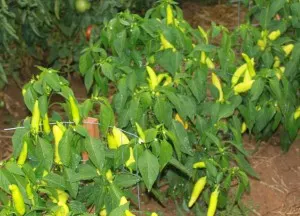
Provide Support:
We all spend time and resources setting up cages and stakes for our tomatoes – why not peppers? Peppers need some support too! We actually use a smaller version of our stake-a-cage method to support our peppers and keep them upright and growing strong. No matter what you use – provide some support for the plants and peppers to grow strong.
Pruning:
Don’t be afraid to cut back a wayward branch. We prune off the bottom foliage from our pepper plants to allow a little light into the plant and to keep pests at bay. Peppers are notorious for breaking off if a branch becomes weighty or too full of peppers. So don’t be afraid to prune a little to keep them growing strong.
Pick Those Peppers!
To keep your plants producing all season long – keep them picked! Pepper plants will continue to produce new peppers as long as you keep the stocks picked. The more tasty veggies you pluck from the plant – the more the plant will continue to spend its energy making more.
Our Favorite Garden Peppers:
Besides the workhorse green bell pepper – here are some of our favorite varieties that we plant, along with some tips on how we use them in the kitchen:
Marconi Pepper – This quickly became one of our favorites last year for grilling and stuffing. It is considered an Italian sweet-style pepper – and therefore no need to worry about the heat with this one. It has fantastic flavor and the heart meaty thick walls stand up well to grilling and baking. It was a big producer in our garden last year – and we picked them both green and red with good results in the kitchen. These will definitely need to be staked – as the peppers grow big and heavy. With their sweeter flavor – they are actually delicious to just slice up and serve on a vegetable tray as well.
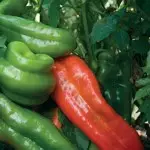
Italian Roaster – If you were to make a hotter version of the Giant Marconi – then the Italian Roaster would be it! A really thick-walled and tasty pepper, they seem to get much hotter when left to turn red on the vine. The green ones are delicious and still pack a little heat – but as they turned red in our garden – we definitely noticed a turn up in the heat! This is another variety that you will definitely want to provide support for. We grew them for the first time last year, and the plant produced well all year long, and the peppers became very heavy on the branches.
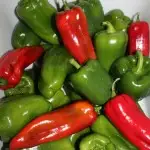
Cajun Belle – The Cajun Belle is the ultimate pepper to have if you love the combination of sweet with heat. They average about 2″ in size, and have a seed core that is easy to remove. They make an incredible stuffed appetizer, are great to chop up in salads and salsa or chili, or to use on a sandwich. An added benefit of the Cajun Belle – they freeze really well and are great to pull out for use during those cold winter months. The plants are absolutely beautiful in the garden or landscape – filling up with 50 or more brightly colored peppers ranging from green to orange to bright red when fully ripe.
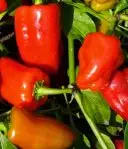
Hungarian Sweet Wax Peppers – These are a massive producer of 4 to 6″ long sweet peppers. Peppers will turn from light yellow to a deeper red and even orange when they mature. They are amazing on salads, sandwiches, and do well as a grilled sliced pepper for brats. The plants themselves grow to around 24″ in height. We grow both a sweet variety and the hot yellow wax pepper to use in Mary’s hot pepper mustard.
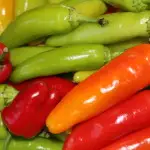
Mini Belle Peppers – These plants will grow to be about 18″ to 24″ high and are covered in tons of 1″ to 2″ mini bell peppers at a time. They have a super small seed core that is easy to remove, and are perfect for salads and salsa. This is also one of our favorite peppers to use for making great appetizers. We use a good spicy sausage and cream cheese stuffing that makes for an incredible paring with the sweet taste of the peppers. They look great in the landscape too as an accent plant – adding a splash of color wherever you put them.
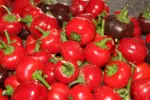
Mariachi Pepper – Another sweet-heat type pepper that almost has a fruity taste to it. I would classify this pepper more as a sweet and fruity pepper than as a hot pepper. It turns from green to yellow to red – and can be picked at the yellow or red stage with the same great flavor. The plants are about 24 to 30″ in height and stay strong all year – producing peppers as long as you keep picking. Great in salads and salsa, or a sandwich – and perfect to grill or stuff. We also dried some last year and added to our own mixture of dry spice. If they are well watered and it is a cool summer – they tend to be more on the mild side. With less water and more sun and heat – they turn out with a little more kick! Another one to support with a stake or cage.

Poinsettia Peppers – These are actually classified as an ornamental pepper – but they have a fiery hot taste and look great in the landscape or garden. Poinsettia peppers grow to about 16 to 24″ tall – with the pods coming on in late June. Each plant is covered in hundreds of the pepper pods. They start out as an ordinary slim green pepper – and then turn to an incredible fiery deep red from early August until well after the first frost. They are a tasty little pepper that can be added to stir fry to give off some deep heat – or you can put them in olive oil to have hot pepper oil. Poinsettia peppers are another easy seed to save and require little maintenance
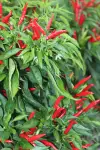
Happy Gardening – Jim and Mary
If you would like to receive our DIY & Gardening Tips every Tuesday – be sure to sign up to follow the blog via email in the right hand column, “like” us on Facebook, or follow us on Twitter

